How to Live Stream Sports: Making Your Virtual Sporting Event a Success
In 2025, live sports streaming has become one of the most popular streaming categories worldwide. Recent trends show a sharp increase in fans ditching traditional cable TV in favor of sports streaming platforms. Approximately 28% of Americans enjoy watching their favorite sports event through a streaming service. This shift is driven by the convenience and accessibility of live-streaming sporting events, allowing viewers to watch anytime, anywhere, and on any device.
Understanding how to livestream sports events has become essential for organizations, teams, or enthusiasts looking to broadcast their events. To help you stay ahead, we’ve compiled a comprehensive guide covering everything from the necessary equipment and streaming platforms to expert tips on creating engaging and professional streams. Whether you’re streaming for a local league, a virtual fan base, or a global audience, these steps will ensure your virtual sporting event is a resounding success.
Let’s explore the 10 key steps to mastering how to live-stream sports events, explore the best streaming solutions, and learn how to deliver a seamless experience to your audience.
Table of Contents
- Why Live Stream Your Sports Event
- Choosing the Right Streaming Platform
- How to Live Stream Sporting Events: The Basics
- Monetization Strategies for Live Streaming Sporting Events
- Legal and Licensing Considerations for Live Sports Streaming
- Video Techniques for Live Streaming Sports
- The Future of Sports Streaming
- Conclusion
Why Live Stream Your Sports Event
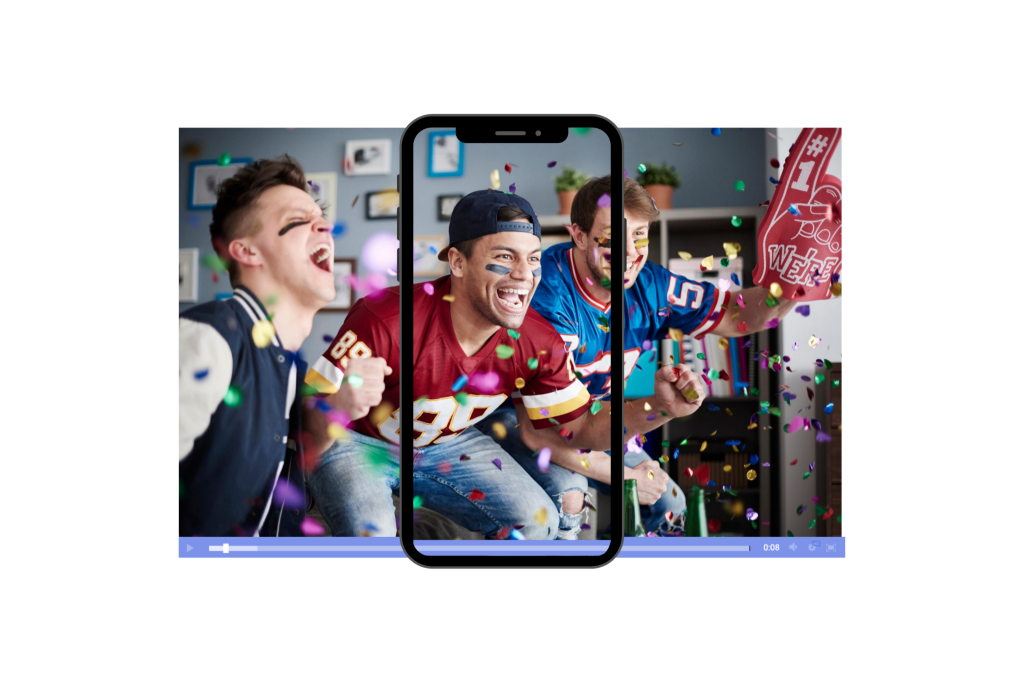

Over the last two decades, the media industry has undergone a dramatic transformation, with live streaming emerging as the dominant way people consume content. In 2025, live-streaming sporting events continue to grow in popularity, fueled by advances in technology and changing viewer habits.
Recent data shows that over 40% of global sports fans now regularly stream sports events online, with platforms like YouTube, Twitch, ESPN+, and Amazon Prime Video leading the way in sports streaming adoption. Even in less developed nations, mobile networks are leapfrogging ahead of more infrastructure-dependent and expensive technologies like TV.
This shift offers significant advantages for sports organizers, broadcasters, and fans alike. So, let’s see why live streaming your sports event is not just a trend but a necessity.
Global Reach
The greatest benefit of live-streaming international sports is the ability to connect with audiences worldwide. Thanks to improved internet speeds and mobile networks, even regions with previously limited access can now join the global sports community.
It’s worth mentioning that many global events have benefited from live sports streaming in recent years. Here are some that are worthy of mentioning:
- FIFA World Cup: The 2022 FIFA World Cup in Qatar broke streaming records globally. Over 5 billion people engaged with World Cup content, with streaming platforms like YouTube, FIFA+, and regional broadcasters offering live coverage. In the U.S. specifically, the final between Argentina and France had 16 million streaming views on Fox Sports and Peacock, marking the most-streamed FIFA game in U.S. history.
- Olympic Games: The 2024 Paris Olympics used streaming platforms to deliver 4.5 billion hours of live content, making the games accessible worldwide.
- 2023 Champions League Final: The 2023 finals provided a big boost to viewers adopting live streaming sporting events. Based on the numbers, it attracted 45% more unique viewers and 39% more plays.
- Super Bowl: The Super Bowl LVII (2023) drew a record-breaking 7 million digital-only viewers through streaming platforms like Fox Sports, YouTube TV, and Hulu Live. Interactive ads, second-screen experiences, and real-time stats made the streaming experience richer than traditional TV broadcasts.
Live streaming is also vital for smaller, localized events looking to expand their footprint. Community leagues, niche sports, and international tournaments can now attract fans, sponsors, and participants globally, creating opportunities to increase engagement and revenue.
Revenue and Paywall Opportunities
With the rise of sophisticated sports streaming platforms, live streaming has become a lucrative avenue for monetization. Two widely used video monetization models include pay-per-view and subscription-based models. These monetization models are especially well suited for live sports streaming, where you can use an integrated paywall to monetize your sports broadcasts, making them a great fit when you’re seeking a financially effective approach.
Pay-per-view (PPV) means charging viewers a one-time fee to access a specific event. This model is especially successful for high-demand games like boxing or championship matches. For instance, the 2023 FIFA Women’s World Cup utilized PPV in select markets, generating significant revenue.
Subscription-based streaming platforms like ESPN+ and DAZN offer viewers unlimited access to a variety of sports for a monthly or yearly fee. This model encourages long-term viewer retention while providing broadcasters with steady revenue
At Dacast, we have plenty of experience with live-streaming revenue generation. If you sign up today, you can test our monetization tools and other powerful live-streaming features risk-free for 14 days.
Consumer Choice and Engagement
For viewers, live sports streaming is all about unparalleled flexibility and choice. Fans no longer need to adhere to cable TV schedules or regional broadcasting restrictions. Instead, they can watch games live or on-demand on the device of their choice.
For broadcasters, this flexibility also opens new creative opportunities. Many leagues now package their streams with interactive features, such as:
- Multiple camera angles (e.g., used by the NHL and MLB in their apps)
- Real-time stats and live scores from concurrent games
- Multiview options allow fans to watch multiple games simultaneously
- Free or viewer paywall for live events, including live sports broadcasts
- Geographic restrictions limit access to streaming content based on IP addresses to comply with contract rules and licensing agreements
Choosing the Right Streaming Platform
We talked about choosing a hosting platform, but you’ll need to get an idea about what specific popular platforms offer. For instance, Dacast is best for professional-level, monetized sports events that require full branding control and advanced analytics.
On the other hand, Twitch is an excellent option for interactive and niche sports events, particularly eSports and gaming tournaments. If you are looking for maximum visibility without heavy monetization, than YouTube is your best option.
Here is a comprehensive overview of what you can expect from each of these platforms:
| Platform | Key Features | Pricing | Pros | Cons | Best Use Cases |
|---|---|---|---|---|---|
| Dacast | – White-label streaming – Monetization options (PPV, subscriptions) – High-quality CDN (Akamai) – Built-in paywalls – Analytics – Global reach | Starts at $39/month for basic plans, with advanced plans at $188/month for larger events | – Professional-grade features – Supports paywalls – Ad-free – Excellent analytics tools | – Expensive for smaller events – Requires technical setup for beginners | – Large-scale sports events – Monetized broadcasts – Leagues and organizations aiming for branding |
| YouTube Live | – Unlimited streaming – Integrated with YouTube platform – Analytics tools – Free audience reach – Supports DVR features | Free (Ad-based revenue) or YouTube Premium options for creators | – Massive audience potential – Free platform – SEO and discoverability | – Limited monetization tools – Ads interrupt streams unless you disable them | – Community-level sports – Sports highlights – Broad reach without monetization priority |
| Twitch | – Real-time audience interaction (chat) – Monetization tools (subscriptions, bits) – Immersive community features | Free (Platform takes a percentage of monetization revenue) | – Highly engaging for niche sports – Monetization options – Built-in community interaction | – Discoverability is competitive – May not feel “professional” for traditional sports events | – eSports tournaments – Niche sports or smaller leagues – Highly interactive events |
| Facebook Live | – Instant audience access via Facebook – Interactive features (polls, comments) – Boosted posts for wider reach – Free basic streaming options | Free, with paid promotions or boosted posts for greater reach | – Large built-in audience – Easy to set up and share – Interactive features | – Limited monetization tools – Ad-based revenue, not suitable for professional-grade broadcasts | – Local sports events – Building a community around a team or league |
| ESPN+ | – High-quality professional sports streaming – Subscription-based revenue model – Exclusive rights to major sports leagues (NFL, NHL, UFC, etc.) – HD quality | $9.99/month or $99.99/year, PPV pricing for specific events | – Highly professional platform – Access to exclusive sports content – Massive sports audience | – Limited to partnered organizations – Expensive pay-per-view for major events | – Professional sports – High-profile leagues – Exclusive and large-scale sports coverage |
How to Live Stream Sporting Events: The Basics
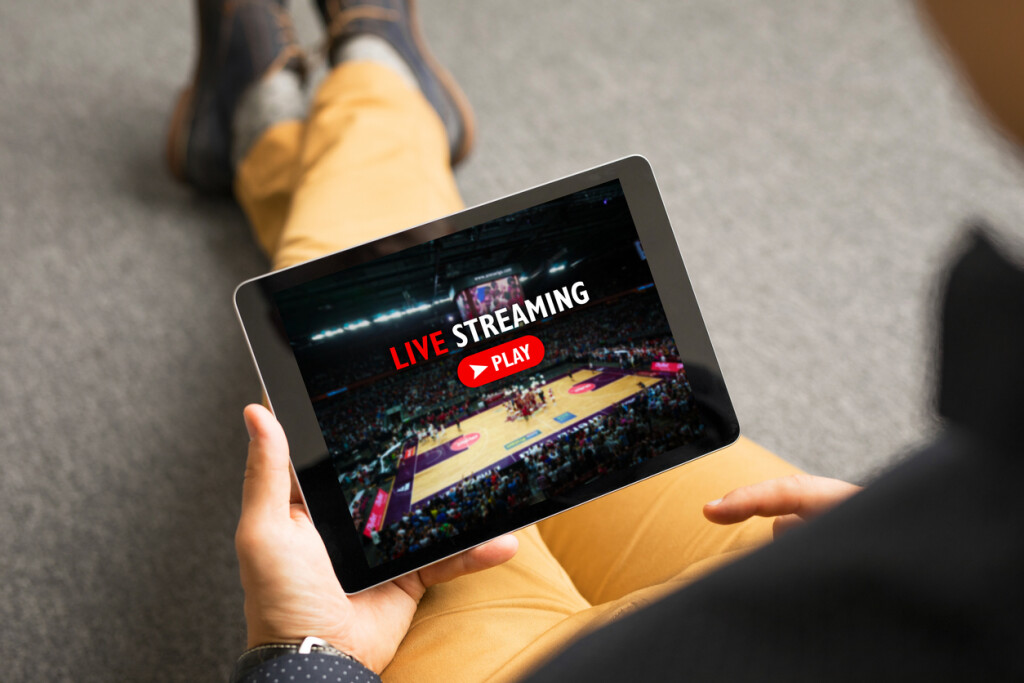

Streaming sporting and live events is relatively simple, even for those new to the game. Start by planning and preparing for your stream, and then decide which equipment, encoder, and live-streaming host you’ll use. The final step is promoting your stream and conducting several runs, after which you’re ready to start.
We have prepared ten steps to follow to get your first sports stream up and running.
1. Plan and Prepare
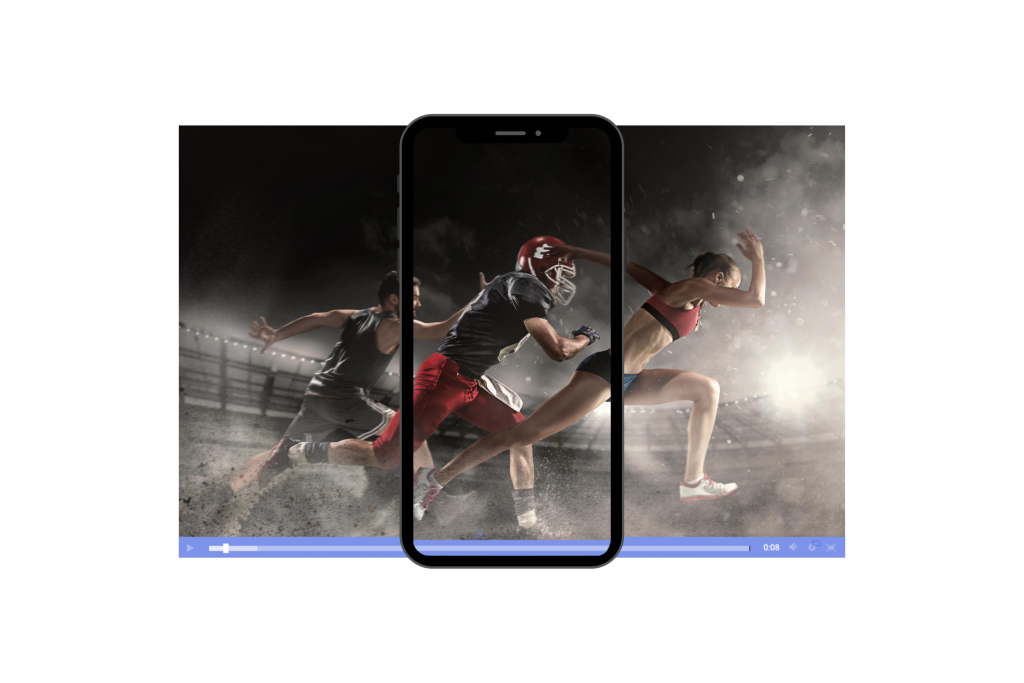

Planning and preparation are key when setting up your first live stream. This is mainly because each broadcaster’s situation is unique, and a significant part of the streaming process depends on individual goals.
Before you begin, clearly define your goals and logistics for live streaming your sporting event. Ask yourself:
- Who is my target audience? Are they local or global?
- Do I want to monetize my broadcasts? If so, which monetization method fits best (pay-per-view, ads, or subscriptions)?
- What is my budget, and how will I allocate it between equipment, platform fees, and promotion?
- How often will I be streaming? Is this a one-time event or part of a regular schedule?
To ensure compatibility, you should also identify the devices your audience will likely use (smartphones, TVs, laptops). Having a solid plan sets the stage for a seamless execution.
2. Invest in Professional-Grade Equipment
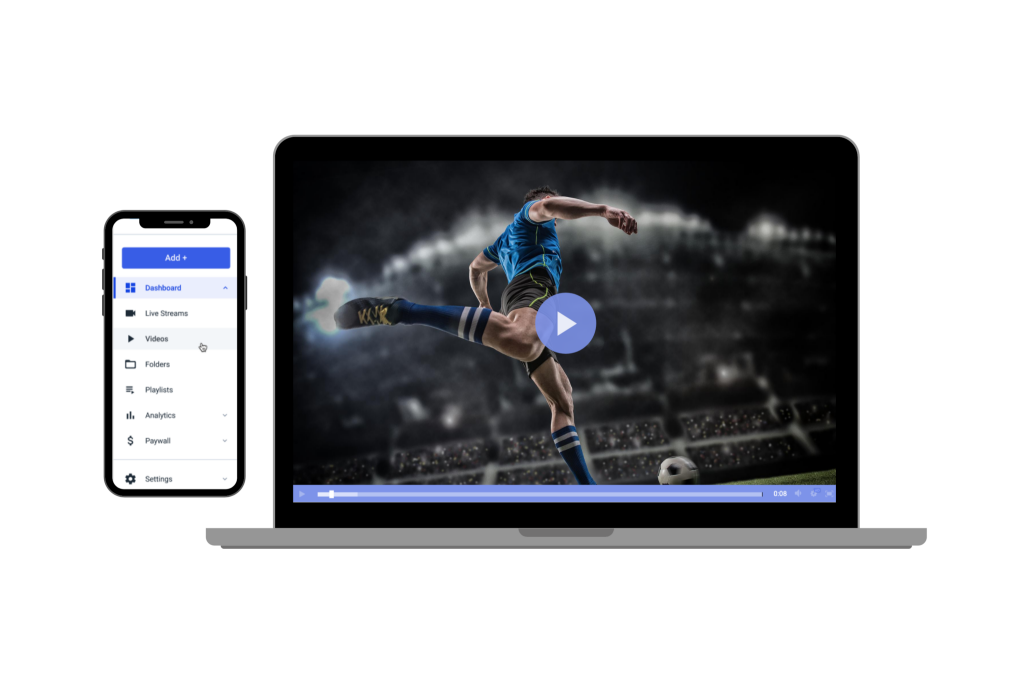

Quality equipment is one of the main factors of live sports streaming. The dynamic nature of sports requires sharp visuals and clear audio, which is why you’ll need to acquire the essential equipment.
Let’s start with cameras. You should invest in at least one high-definition (HD) or 4K camera with optical zoom to capture fast action from a distance. Multi-camera setups provide diverse angles for a professional feel. Options like the Sony PXW-Z90 or Canon XA75 are great for sports. The use of tripods and gimbals for your camera will ensure smooth footage.
To complete the setup, you’ll also need audio gear. You should go with external microphones like lapels and shotgun mics for commentators. There is also the moment of crowd noise that should be considered. For this, you’ll want to add ambient mics to capture the stadium’s energy.
Encoders are essential because they convert the video content you record into a viewable format for your viewers’ devices. The encoding device can also be relatively simple. If you’re on a budget, use a hardware encoder like the Teradek Vidiu X for high-quality, low-latency streams or software encoders like OBS Studio.
Lighting is another important factor to consider. Ensure proper lighting with LED panels like the Godox SL150II for indoor events for balanced, flicker-free illumination.
A dedicated, stable internet connection with at least 10 Mbps upload speed is vital for HD streaming, especially for 60 fps sports footage. There is a lot of motion in the picture, which can use extra bandwidth, therefore, 10 Mbps or higher is the best practice for live sports streaming whenever possible. Also, use a backup connection (e.g., mobile hotspot) as a failsafe.
3. Choose the Right Video Hosting Platform
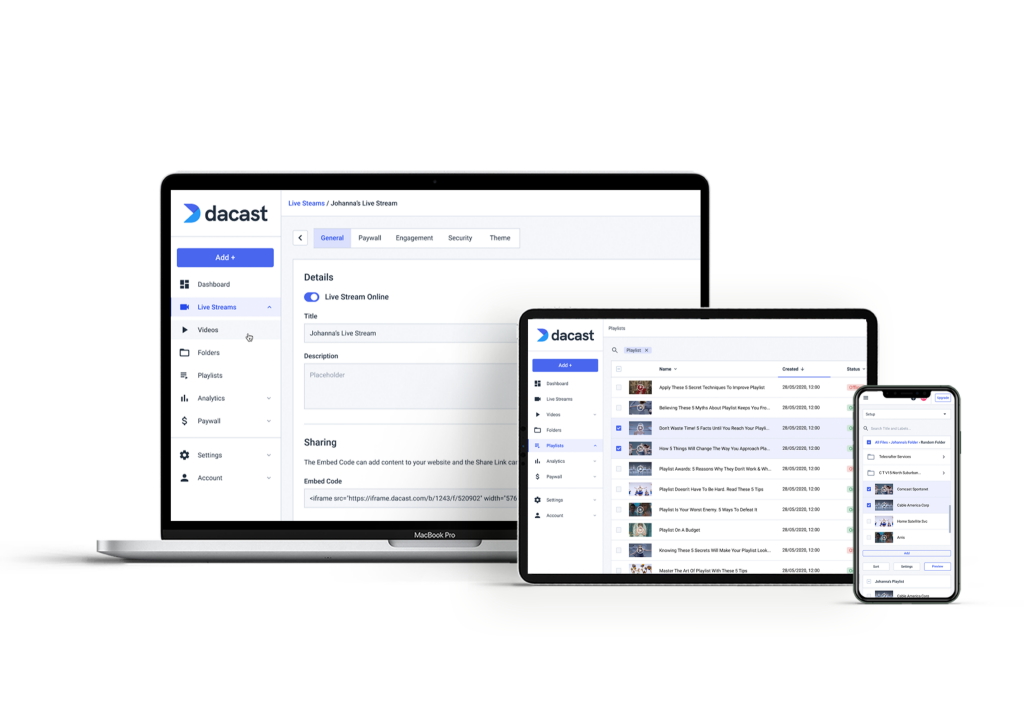

Sports broadcasting requires special video hosting tools that may not be available on every platform. This is why you need to select a sports streaming platform that supports your needs. Some top choices include:
- Dacast: For professional sports broadcasting with monetization tools and high-quality content delivery
- YouTube Live: Best for audience reach and discoverability
- Twitch: Great for engaging with fans in real-time
- ESPN+: Ideal for premium or large-scale sporting events with subscription models
Ensure the platform offers features like adaptive bitrate streaming, white-label branding, monetization options, privacy and security settings, 24/7 customer support, and global CDN (Content Delivery Network) support for smooth viewing experiences across varying internet speeds.
The most common way to distribute content is to embed your live stream to your website. Please note that your viewers will not access your stream directly through this host but rather on your website or app where you embed the video player from this platform.
4. Secure the Right Licenses and Permissions
Acquiring the right licenses and permissions is a big must and a very important step. Verify that you have the necessary permissions to broadcast your sporting event. This includes:
- Licenses for music or copyrighted material used during the stream
- Agreements with players, coaches, and organizations for filming and distribution rights
This is just a reminder that overlooking legal aspects can lead to fines or takedown notices. If necessary, we recommend that you consult a legal advisor to ensure that things are done correctly.
5. Set Up and Test Your Equipment
Setting up and testing your equipment on-site before going live is advisable. Do a complete setup at least a day before the event to identify and fix any issues.
- Test Video and Audio: Ensure cameras capture clear visuals from all angles and audio levels are balanced (commentators shouldn’t overpower crowd noise).
- Internet Speed: Use tools like TestMy.net to confirm upload speeds meet streaming requirements.
- On-Site Setup: If possible, do a dry run on location to test lighting, camera placement, and connectivity.
We recommend doing multiple test runs to make sure everything is working properly. And here is a pro tip: Always have extra batteries, backup SD cards, and cables on hand in case of technical issues.
6. Promote Your Broadcast
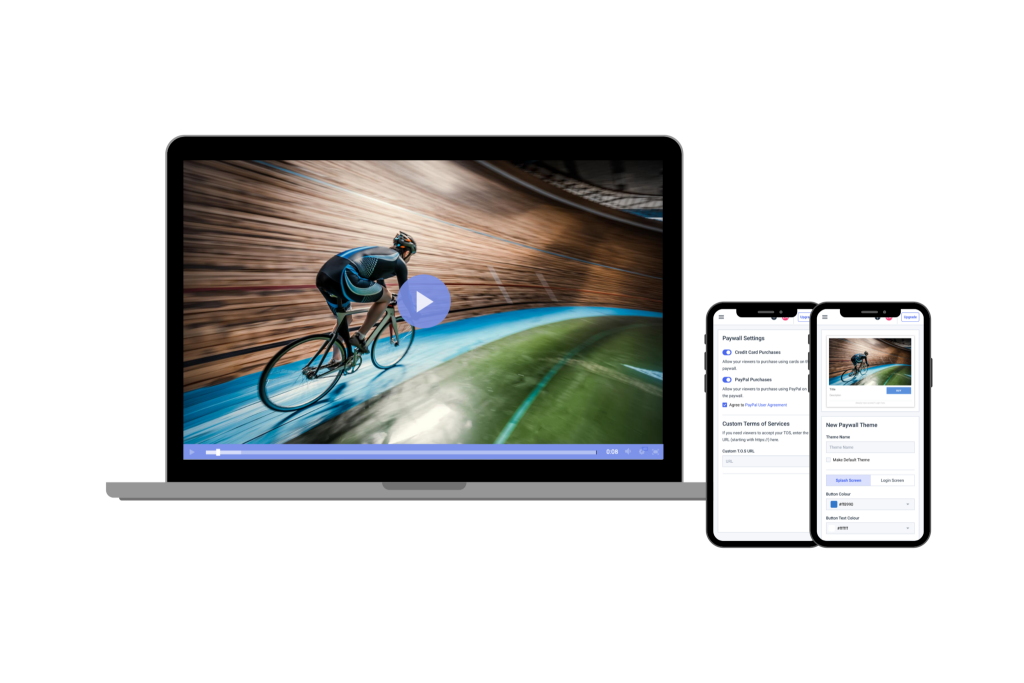

With so much work invested in this broadcast, promotion is critical to attracting viewers to your livestream. To have your fans tune in, you have to let them know that your sporting event will be live. We recommend that you use these strategies:
- Create social media campaigns, including posts, teasers, and countdowns on platforms like Instagram, Facebook, and Twitter
- Reach out to parents, local communities, or fans of the team through email and text blasts
- Use paid ads to boost visibility on platforms like Facebook and YouTube and expand your reach
- Use sports-specific hashtags and collaborate with influencers or athletes to amplify your promotion
7. Monetize Your Stream
There is also an option to monetize your sports coverage with various video monetization options, such as ad-based video on demand, subscription, pay-per-view streaming, and sponsorships.
We recommend choosing a monetization strategy that is based on the preferences and audience size. Regardless of the targeted audience, let them know that you are streaming pay-per-view sports so they can find you online.
8. Monitor the Stream in Real-Time
You are now ready to start streaming. Starting a live stream is as simple as clicking a button on most online video hosts. During the event, assign a team member to oversee the stream in real time. Their tasks are to monitor video and audio quality, engage the audience in live chat if applicable, and address technical issues promptly.
Platforms like Dacast allow you to track key metrics like viewer count and connection stability. If you are streaming with Dacast and have questions or concerns during your stream, feel free to call our 24/7 support team for real-time troubleshooting.
9. Engage with Viewers
Audience engagement makes your stream more interactive and memorable, and there are several approaches you can use. Add live commentary to explain the action and highlight key moments, or use real-time polls or Q&A sessions to interact with viewers during breaks. Your third option would be to incorporate replay clips for crucial plays using relevant software.
Broadcasters know that building a connection with viewers is essential. It encourages them to return for future events, which means that you have been a success.
10. Analyze and Improve
Once the event is over, it’s time to evaluate the success of your live stream. You should use analytics tools from your streaming platform to assess metrics like total viewers, watch time, and audience demographics. It’s very useful to collect feedback through surveys or comments to identify areas for improvement. Your final step is to refine your process for future streams, whether it’s upgrading equipment or enhancing viewer engagement strategies.
Monetization Strategies for Live Streaming Sporting Events
Monetizing your live sports streaming can help offset production costs and even generate significant revenue if implemented effectively. We will discuss the three primary monetization strategies along with actionable tips and examples to help you decide the best approach for your sporting events.
Ad-Based Monetization
Ad-based monetization helps you generate revenue by displaying advertisements during your live stream. This is an excellent choice for free-to-view events with a large audience. Ads are shown before (pre-roll), during (mid-roll), or after (post-roll) the stream. It’s worth noting that the revenue is based on impressions (CPM – Cost Per Thousand Impressions) or clicks (CPC – Cost Per Click). The good thing here is that you can partner with ad networks like Google AdSense for Video or directly sell ad space to sponsors.
For example, YouTube Live offers built-in ad monetization if your channel meets the requirements for the YouTube Partner Program (at least 1,000 subscribers and 4,000 watch hours in the last 12 months). Another possibility is Twitch. Streamers can run ads for extra revenue, with Twitch sharing a percentage of ad earnings.
We can offer you the following actionable tips:
- Integrate sponsorship ads and partner with local businesses or brands to display their logos, banners, or video ads during breaks in the action.
- Platforms like YouTube and Facebook Live allow you to target ads based on viewer demographics, ensuring relevance and higher engagement.
- Time your ads carefully to avoid interrupting crucial gameplay moments. Instead, schedule mid-roll ads during natural pauses like halftime or breaks.
Subscription-Based Monetization
With a subscription-based model, viewers pay a recurring fee to access your content. This is ideal for ongoing leagues, tournaments, or regular sports broadcasts. So, how does this work? Subscribers will pay a weekly, monthly, or yearly fee for unlimited access to live and on-demand sports streams. You can offer tiered pricing, with higher tiers unlocking exclusive perks (e.g., behind-the-scenes footage, no ads, or premium camera angles).
We will use ESPN+ as an example. It offers a subscription plan where users can stream live sporting events, documentaries, and exclusive content for $9.99/month. Patreon is another option sports creators can use to offer behind-the-scenes training videos or exclusive Q&A sessions as subscription perks.
Here are some actionable tips you may find useful:
- Add premium features such as multi-camera views, real-time stats, or post-game analysis to justify the subscription fee.
- Offer free trials and allow new users to test your service for free for 7-14 days to encourage sign-ups.
- Partner with other sports-related services (e.g., merchandise or fitness apps) to offer bundled packages that add extra value for subscribers.
Pay-Per-View Monetization
In a pay-per-view (PPV) model, viewers pay a one-time fee to access a specific event. This is an excellent choice for high-demand games, tournaments, or exclusive sports events. Here, viewers purchase tickets for individual live streams, which may include access to replays or additional features.
For instance, pay-per-view is a staple in combat sports, with major boxing and MMA events hosted on platforms like ESPN+ or DAZN, where fans pay $50 or more per event. At the same time, high school championship games or regional league finals often use PPV to recoup production costs.
Our actionable tips for this category include the following:
- Price your streams based on the perceived value and target audience. For instance, charge $5-$10 for local games and $20-$50 for larger events.
- Offer exclusive features for PPV buyers, such as access to post-game highlights, interviews, or downloadable content.
- Provide discounts for viewers who purchase tickets in advance to boost sales before the event.
Engaging Your Audience in Live Sports Streaming
Interactive tools and strategic promotions can turn passive viewers into active participants, enhancing the excitement of the event and building loyalty for future broadcasts. You can always find ways to captivate your audience and create an unforgettable live streaming experience. One way is by using interactive tools which allow viewers to feel like part of the action.
Live Polls and Q&A
Live polls and Q&A enable viewers to vote on game predictions, MVPs, or outcomes in real-time or ask questions about the game. To implement this, integrate platforms like Streamlabs, Slido, or Poll Everywhere with live streaming platforms like YouTube Live, Twitch, or Dacast. Display results in real-time as overlays. For example, during a halftime break, launch a poll asking viewers, “Who will win the game?” or “What’s your favorite play so far?”
Instant Replays and Highlights
Instant replays and highlights is a great way to give viewers the ability to revisit key moments during the game, such as goals, touchdowns, or highlight-worthy plays. Use a relevant software to queue up instant replays, and combine with multi-camera setups for dynamic views of each highlight. What you can do is rewind a crucial play immediately after it happens and add commentary to keep the audience engaged.
Multi-Angle Camera Views
This tool lets viewers choose their perspective, whether it’s from the sidelines, behind the goal, or overhead. Platforms like Dacast allow you to set up multi-angle streaming. Use a web interface or app to let viewers toggle between views.
Chat Features and Interactive Overlays
This tool allows fans to interact with one another, comment on the game, or ask questions. Overlays provide real-time updates, such as live scores or player stats. Use built-in chat systems (e.g., YouTube Live Chat, Twitch Chat) or third-party tools like Restream Chat. Add overlays with tools like StreamElements or Streamlabs OBS.
For instance, use overlays to display real-time stats, like “Top Scorers” or “Live Game Clock,” while a chat moderator engages fans.
Using Social Media for Promotion
Social media promotion is a fantastic way to maximize your audience. This can be done in three phases:
- During the pre-event promotion, you can share short, engaging videos highlighting star players, past games, or behind-the-scenes footage. You should also share the date, time, and link to your live stream at least 2-3 weeks in advance on platforms like Instagram, Facebook, and Twitter. Develop event-specific hashtags, and partner with influencers, athletes, or sports organizations to promote your event through their networks.
- Phase two is during the event when you can go live on social media and stream highlights, behind-the-scenes footage, or pre-game interviews on Instagram Live, Facebook Live, or TikTok Live to encourage viewers to tune in. Ask viewers to share the stream link with their followers, while you offer incentives, such as giveaways or shoutouts, to those who do. During this time, post live tweets or stories with game highlights and direct links to the stream.
- And the third phase is the post-event engagement. This is where you share short clips of key moments to keep the conversation going after the event. Post a “Thank You” message to fans and include a teaser for your next event. Ask for viewer feedback on social media to improve future streams
Legal and Licensing Considerations for Live Sports Streaming
Live sports streaming is an exciting opportunity to engage global audiences and monetize content, but it also comes with important legal and licensing responsibilities. To protect your business and avoid potential legal disputes, you must address broadcasting rights, copyright laws, and geographic restrictions.
The Importance of Acquiring Broadcasting Rights
Broadcasting rights are legal agreements that give individuals or organizations the exclusive authority to record, broadcast, and distribute live sporting events. These rights are typically held by sports leagues, event organizers, or teams. Without proper licensing agreements, streaming sports events can lead to legal action, penalties, or takedown notices.
Why do you need them? They are essential in avoiding copyright infringement and helps build professional relationships with leagues, teams, or event organizers, leading to potential partnerships or sponsorships. Keep in mind that without the rights, you may not be legally allowed to monetize your stream.
Here is what you need to do to acquire broadcasting rights. Research which entity owns the broadcasting rights for the event you want to stream and contact them to negotiate the scope, duration, and terms of the license. Be prepared to provide details about your platform, audience, and monetization plans. Review the licensing agreement carefully to understand any restrictions and keep a clear record of your agreement to prove compliance if legal issues arise.
Addressing Geo-Blocking and IP Management
Geo-blocking is a method of restricting access to content based on a viewer’s geographic location. Many sports leagues sell broadcasting rights on a regional basis, meaning your stream may only be accessible in specific countries or territories. It is an important factor in avoiding legal penalties due to violation of regional restrictions which should be in compliance with the licensing agreements.
There are several ways that geo-blocking can be implemented:
- With the help of IP detection technology and tools like GeoIP databases or content delivery networks (CDNs), you can detect a user’s location based on their IP address.
- Work with a streaming platform that offers built-in geo-blocking functionality, such as Dacast.
- Set up your streaming platform to allow or block specific countries or regions based on your licensing agreement.
You can also use some of the best practices for IP management like content, encryption, copyright protection and monitoring of unauthorized stream. Use digital watermarking or rights management systems to identify and address unauthorized use of your content. You can also employ tools like DMCA takedown services to identify and report pirated streams of your event. And finally, use encryption protocols like AES-128 or DRM (Digital Rights Management) to prevent unauthorized recording or redistribution.
Video Techniques for Live Streaming Sports
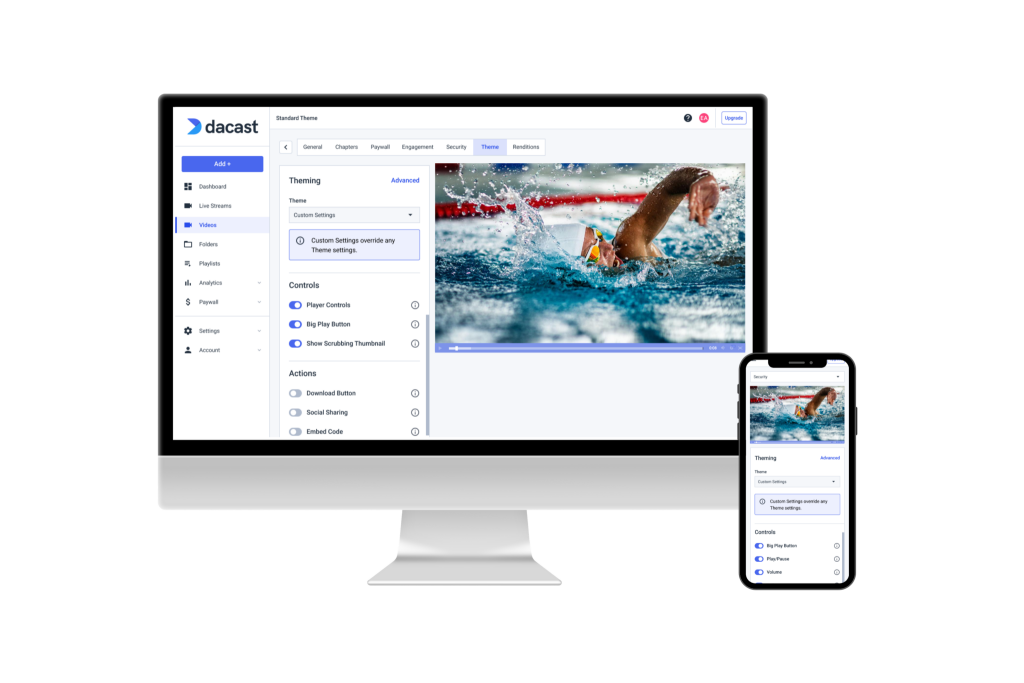

Use an HTML5 Video Player to customize your live sports streaming and ensure videography styles are consistent throughout the rebroadcast. At this point, you should have a good idea of how to livestream sporting events, so we want to leave you with a couple more tips that will help you take your live-stream sports event to the next level.
- When filming any sporting event, work camera operators who are familiar with how the specific sport works.
- For live sports streaming, you should employ a minimum of two cameras: one to zoom in on the site of play and another to maintain a wider angle on the crowd.
- You’ll also need a tool to control the camera’s motion. At a minimum, this means using a tripod. For higher-quality shots, you’ll want a fluid-head tripod that pans smoothly and cleanly. You may also want to consider a jib arm or track to achieve some camera movement in your shots.
The Future of Sports Streaming
The future of live sports streaming is poised to revolutionize how fans experience their favorite games, thanks to advancements in artificial intelligence (AI), virtual reality (VR), and 5G technology. These innovations are enhancing viewer engagement, improving accessibility, and pushing the boundaries of immersive entertainment.
AI is already transforming sports streaming by enabling personalized and automated experiences. AI-powered tools provide instant game stats, player performance metrics, and predictive insights during live streams, enhancing the viewing experience. Due to the automated production feature, AI cameras can track players, pan across fields, and switch angles automatically. This makes professional-grade streaming more accessible for smaller leagues and amateur events. Another perk is that AI algorithms analyze viewer preferences to offer customized highlights, tailored notifications, and recommendations for upcoming games.
On the other hand, VR is redefining how fans interact with live sports by offering a front-row seat from anywhere in the world. Using 360-degree streams, viewers can explore stadiums, follow players on the field, and experience games from multiple perspectives. VR is also being used by athletes for performance analysis and virtual training simulations. And there is the option of fan interaction. Virtual watch parties and interactive VR events are bridging the gap between remote and in-person fans, fostering a sense of community.
Conclusion


You’re now equipped with the essential steps and best practices to live stream sports events successfully. You have all the tools needed to deliver an exceptional streaming experience from planning and equipment setup to platform selection and audience engagement. Whether your viewers are watching through a web browser, mobile devices, smart TVs, or even gaming consoles, you can now confidently provide a professional and seamless live sports streaming service.
As we discussed, choosing a robust video hosting platform is crucial for ensuring smooth delivery and monetization of your broadcasts. With Dacast, you have access to an all-in-one solution tailored for live sports streaming. Dacast empowers you to stream live and on-demand content across all devices, including your own OTT apps, with features like professional-grade video quality, advanced monetization options, and secure content delivery.
Ready to elevate your sports broadcasts? Try Dacast risk-free with our 14-day free trial and explore how its advanced features can help you unlock new revenue opportunities while engaging your audience like never before.
For even more insights, exclusive offers, and expert tips on live streaming, join our growing LinkedIn community and take your sports streaming game to the next level.


